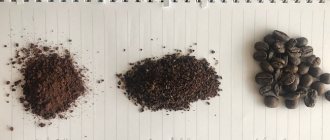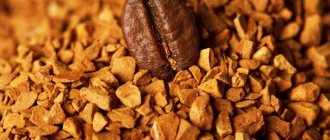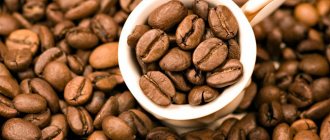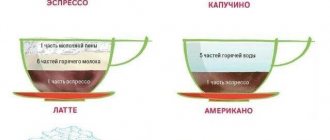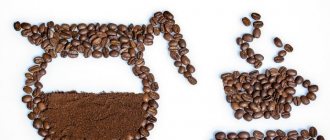Let's talk about humanity's favorite drink - coffee. More precisely, what kind of coffee should you buy in the store: beans or already ground?
The question seems simple, but there is a mystery here. Have you noticed that coffee of the same brand in a 250 gram package, but in different states costs differently. For example, ground coffee costs 150 rubles, and the same coffee beans costs 300 rubles. Why such difference? The weight is the same.
Soluble or natural?
Both instant and ground natural coffee are extremely common throughout the world and are in great demand. However, they have significant differences.
Soluble
Instant coffee is a drink made from coffee beans that have been processed to turn them into powder or granules that are soluble in water. The first stage of production is roasting the beans and subsequent grinding. The mixture is then poured with hot water and dried in various ways, which determine the type of instant coffee:
- Sublimated. The crushed grains are frozen and dehydrated in a vacuum environment. Freeze-dried coffee is distinguished by the preservation of almost all nutrients and high cost.
- Powder. The mixture is sprayed into a stream of hot air, then quickly dries and turns into powder. This option is the cheapest on the market and has a weak taste and aroma.
- Granulated. Made from coffee powder. The powder is moistened in water, then pressed until granules appear.
The main advantages of instant coffee are low cost and long shelf life.
Negative aspects - less pleasant (rich) taste and aroma, low caffeine content (2-3 times less than in a natural product).
But the main disadvantage of instant coffee is the high content of a toxic substance - acrylamide (about 2 times higher than in natural coffee). This substance can provoke the growth of malignant tumors (ovaries, endometrium), depress mental work, reduce fertility and increase the likelihood of early development of type II diabetes mellitus. American scientists came to these conclusions.
Natural
Natural coffee is a drink made from ground whole coffee beans. There are over 90 plant species growing in the world that belong to the genus Coffea, but only a few varieties are produced on an industrial scale:
- Arabica. The most common option (up to 90% in the world). The grains have an oblong shape and a smooth surface. During the roasting process, many unburnt areas remain due to the presence of an S-shaped groove.
- Robusta. It is characterized by a high caffeine content and a less pleasant aroma compared to other varieties. The share of world coffee is 5-7%. It is usually used not in pure form, but as mixtures, which makes the final drink cheaper. The grains have a round shape, without features.
The key stage in the production of natural coffee is roasting the beans. It is during this procedure that the beans acquire their characteristic brown color, the severity of which is determined by the degree of roasting. There are 4 degrees of roasting:
- light (Scandinavian);
- medium (Viennese);
- dark (French);
- very dark (Italian).
With a high degree of roasting, coffee beans lose valuable nutrients and also accumulate compounds that are toxic to the body, for example, acrylamide. However, the higher the degree of roasting, the brighter the taste and aroma. You should not overuse very dark varieties of coffee.
Scientists say that it is natural, freshly ground light and medium roast coffee that is most preferable for humans. See 14 beneficial properties of natural coffee here →
Comparison table
To understand which drink is healthier for a particular person, you should pay attention to the main differences between instant and ground (bean) coffee. They are presented in the table:
| Criterion | Soluble | Natural |
| Antioxidant content | Average | High |
| Taste and aroma | Less pronounced | More pronounced (proportional to the degree of roasting) |
| Caffeine concentration per 1 cup (170 ml) | 60-90 mg | 80-140 mg |
| Acrylamide concentration | 358 mcg/kg | 150-170 mcg/kg |
| Calories per 1 cup | 4 calories | 2 calories |
| Content of macro- and microelements per 1 cup (170 ml) | ||
| Calcium | 7.2 mg | 3.6 mg |
| Omega-6 fatty acids | 3.6 mg | 1.8 mg |
| Magnesium | 7.2 mg | 5.3 mg |
| Phosphorus | 5.4 mg | 5.3 mg |
| Potassium | 53.7 mg | 87.2 mg |
| Sodium | 7.2 mg | 3.6 mg |
| Caffeine | 46.5 mg | 71.2 mg |
Thus, it is recommended to give preference to natural coffee varieties that contain natural, technologically unaltered nutrients. It is important to note that natural coffee beans have a more pleasant taste and aroma, contain fewer toxic substances and have lower calorie content. Of all roast types, you should choose a low or medium level.
How to choose good coffee beans
The coffee industry is so profitable for producers and suppliers that not many of them resist the temptation to make coffee more expensive while reducing its quality. The consumer is interested in not being deceived. How to recognize high-quality coffee and spot a fake in time?
It should be understood that the most expensive coffee does not mean real coffee. Fans of a certain coffee variety would do well to know its external characteristics.
Arabica has indeed always been one of the most expensive varieties, since the coffee tree produces few fruits per harvest. Sourish in taste, the Arabica variety has elongated grains.
Robusta trees produce more coffee fruit per harvest, making it much cheaper than Arabica. The cost of Robusta also means a less intense aroma. Robusta tastes more bitter and the grains are rounder.
It is almost impossible to fake coffee beans. Although such attempts are also known: using starch, flour and dyes with the addition of water, scammers sometimes achieve the desired shape and color of grains, which are practically indistinguishable from real ones. There are known cases of even adding plastic beans, which after grinding are lost in the coffee grounds, but significantly increase the weight of the pack!
How to choose quality coffee beans? a fake by conducting an experiment: coffee beans do not color cold water when they fall into it; if a grain immersed in water produces a brownish trail, it means there is definitely a dye here.
Ground coffee is even easier to counterfeit: ground chestnut, chicory, acorn powder, millet or barley are mixed into it. It’s good at least that such impurities are not harmful to health. The method for detecting counterfeit ground coffee is the same as for bean coffee.
Impurities are often added to instant Robusta coffee that have no odor or natural analogues. Advertising lures the buyer to buy coffee with additives, which are supposedly very good for health. This is just a clever marketing ploy. Few consumers of such super-novelties understand that such expensive coffee may contain cheap beans, milk powder, and sugar. The danger is that milk powder has shelf life limitations. Due to a spoiled ingredient, instant coffee gives a sour taste, and the consumer may mistake this for the “highlight” of the coffee variety.
Starch does not tolerate proximity to iodine, with the help of which you can easily determine the additive in the composition of coffee powder: you just need to add a drop of iodine to the water in which you have previously dissolved the suspicious coffee. If the water turns blue, it means starch is mixed into the coffee.
Which cooking method is best?
As we have already found out above, natural coffee beans are the most preferable option. However, there are different methods of preparing the drink, which have their own disadvantages and advantages.
The following cooking methods are distinguished:
- "Turkish way" (in Turk). Turk is a utensil for making coffee. Usually, for this option, the finest grinding of grains is used, from which the taste and aroma have time to partially “come out.”
- French press. It is a device in the form of a cylinder with a piston-filter. Ground coffee is poured into a flask, filled with hot water (about 70-90 degrees) and infused for 5 minutes. Then the piston is lowered and the drink is poured into glasses.
- Filter coffee. It is done using various filters (most often paper). Ground coffee is poured into the filter and filled with hot water. The drink seeps through the pores and pours into cups.
- Geyser coffee maker. In the device, coffee is poured into one of the compartments, water is poured into the other, and it is installed on any heating surface (for example, on a gas stove). Steam under pressure passes through the compartment with ground coffee and is collected in the next container (with the finished drink).
- In a thermos. The principle is simple: ground grains are poured into a thermos, filled with hot water and left in this state for 1-3 hours.
- In the coffee machine. This device automates the coffee preparation process. Either ground or whole beans are loaded into the coffee machine (in this case, grinding occurs in the machine itself). The principle of operation is to pass hot water through a layer of ground coffee under pressure. Modern coffee machines have many additional built-in functions (milk frothing, etc.)
The most useful option for brewed coffee is “Turkish” (in Turk). During the preparation process, the drink retains the maximum amount of antioxidant substances and macroelements. The only drawback of boiled coffee is its less pleasant taste and aroma. It is important to consume the drink within the first 5-15 minutes from the moment it is ready, otherwise the totality of positive qualities will gradually be lost. Yesterday's coffee has a minimum of nutrients.
Exposure to a water temperature of less than 95 degrees (geyser coffee maker, French press) does not allow valuable components to escape from ground beans and is less useful.
Coffee from a thermos is the most undesirable option due to the long standing time.
There are many options for preparing an invigorating drink, the most useful of which is the “Turkish” method of preparation using Turks. It releases the maximum amount of nutrients from grains.
Ground coffee or coffee beans?
Coffee lovers are constantly tempted to choose an instant or at least ground form of the drink.
This is most often due to the lack of free time to prepare it. Although experts and connoisseurs will argue here: real coffee is not instant, but only freshly ground. It is best to grind grains in the required quantity immediately before cooking, although this may seem tedious. The integrity of coffee beans is the key to its magical aroma and healthy drink. Ground coffee is convenient: pour into a pot and brew. But you should understand that ground coffee loses its beneficial properties extremely quickly, and the finer it is ground, the faster the value of the drink is lost. Even vacuum packaging does not guarantee that coffee will retain its valuable qualities after opening. This is due to the volatility of the essential oils contained in coffee beans. Very fine grinding quickly loses moisture and instantly absorbs surrounding odors, spoiling the quality of the prepared coffee.
This is why purchasing grain coffee is more welcome: in whole beans, all the beneficial substances are “closed” before they are ground. Ideally, immediately after the coffee grinder, the coffee powder goes directly into the Turk, and then into the cup.
Ground coffee is easier to counterfeit: if unscrupulous manufacturers mix cheaper coffee varieties into the powder, then even the most experienced coffee lover will not always be able to visually determine this. When purchasing coffee beans, you can be sure of at least its grade and cost.
It is believed that after grinding, coffee is “alive” only for 15 minutes. If the consumer likes to make coffee themselves using a French press, coffee maker or traditional Turkish coffee pot, then it is best to grind the coffee at home so that there is no doubt about the quality of the drink.
For the office, of course, due to the lack of free time, grain coffee is less suitable, but ground coffee comes in handy. In this case, ground coffee cannot be stored in open packaging. It must be placed in a tightly closed container made of ceramic or glass and stored in a dry and cool place.
For about ten to twelve days, subject to storage conditions, an opened pack of ground coffee retains its beneficial properties. Therefore, although large packs seem to be a more economical purchase, they are still less preferable.
It is no secret that before packaging ground coffee, the raw materials undergo degassing for some time. This is the removal of gases that coffee is capable of releasing into the atmosphere. If you don't create a vacuum in a coffee pack, it will quickly burst. During the process of degassing, coffee loses some of its magical properties and aroma. These features leave no choice: it is more profitable to buy coffee beans.
It's time to know how much caffeine is in coffee
Which coffee drink is healthier?
Many drinks are made based on coffee, the most popular of which are:
- "Espresso". It is prepared (usually in a coffee maker) exclusively from beans with the maximum degree of roasting. It has a low calorie content (7 calories). Served in 30-35 ml cups, it contains approximately 63 mg of caffeine. There are several classic variations: “lango” - diluted with water up to 55 ml, “Americano” - up to 150-160 ml, and “doppio” - double “expresso” (contains approximately 125 mg of caffeine).
- "Cappuccino". It is also produced on an espresso basis. Whipped milk is added to the drink (70-80% of the drink consists of milk). The caffeine content is similar to espresso. All ingredients are served warm in a cup with a volume of 150-190 ml. Energy value – 105 calories per 150 ml glass.
- Macchiato is a mixture of espresso and milk foam in a 1:1 ratio. Volume – 60-70 ml. Nutritional value: 66 calories.
- "Latte" . It is a milk drink. 75% is represented by milk. Served in transparent vessels with a volume of about 200 ml. Energy value – 112 calories.
- Moccacino is a coffee drink with the addition of chocolate, cocoa powder or chocolate syrup. Served in glasses with a volume of 200-250 ml. Contains about 270-320 calories.
Considering the characteristics of each drink, we can conclude that the most useful are “espresso” in its pure form and cappuccino. They are distinguished by sufficient caffeine content and low calorie content.
Which supplements are best?
Traditionally, additional ingredients are added to coffee to give it a more refined taste and aroma, which allows you to enjoy the drink to the fullest. But not all supplements are created equal.
Below are the most popular supplement options and their effect on the body:
- Milk. Softens the bitterness of the drink, enriches it with additional antioxidants. Milk also helps maintain the integrity of the musculoskeletal system and prevent fractures, additionally reduces the risk of malignant neoplasms (colon and rectal cancer), reduces the likelihood of early cardiovascular mortality, and prevents the development of type II diabetes.
- Cream. Cream is the thick, fatty top layer of milk. They improve the taste, but significantly increase the energy value of the drink.
- Sugar. Allows you to reduce the bitterness of the invigorating drink. Belongs to the group of quickly digestible carbohydrates, which are extremely harmful to the heart and the entire body.
- Honey. For a long time it was believed that honey is an excellent alternative to “harmful” sugar, but recent scientific research completely refutes this information. It disrupts metabolism and increases the risk of heart attack and stroke due to its negative impact on the lipid profile.
- Lemon. Adds a special sour taste to the drink. Helps normalize the lipid profile (reduces total cholesterol and the concentration of low-density lipoproteins), prevents the development of cardiovascular diseases and their complications, and is especially effective in lowering blood pressure.
- Turmeric. Scientific research demonstrates that turmeric is beneficial for blood vessels and the heart, provides reliable prevention of atherosclerosis, type II diabetes, and improves the rheological properties of blood.
- Cinnamon. This spice inhibits the activity of pathogenic bacteria in the body, reduces the severity of inflammatory processes in the digestive tract, increases the sensitivity of peripheral tissues to insulin, reduces blood pressure (mainly the systolic component) and strengthens the immune system in general.
- Cardamom. It has general tonic properties and enhances the “invigorating” effect. Helps strengthen local and general immunity factors, slightly inhibits the effects of caffeine (recommended for strong coffee varieties).
- Carnation. The main advantages are a bright rich taste, lowering blood pressure and reducing blood viscosity. Recommended for people with pathologies of the blood coagulation system.
- Ginger. It increases the amount of lipoproteins with a high specific gravity, and reduces those with a low specific gravity, resulting in the prevention of atherosclerosis. Helps increase the activity of metabolic processes (useful for weight loss).
Coffee additives have different effects on the body. It is recommended to avoid adding honey or sugar. It is better to add lemon, turmeric, cinnamon, cardamom and ginger.
Special varieties
- Bulletproof coffee is a high-calorie product based on regular coffee, unsalted organic butter and MCT oils. Promotes weight loss by putting the body into “ketosis” mode and prolongs life in general.
- Decaffeinated coffee or “decaf” is a product from which almost all caffeine (up to 97%) is technologically removed. As a result, there is no effect of this biologically active substance, the list of contraindications for coffee is narrowed (acute inflammatory lesions of the digestive system, refractory arterial hypertension, etc.).
- Cold or iced coffee is a serving option in which the coffee drink is consumed cool, usually in the summer to quench thirst and improve performance. There are 2 main cooking options: diluting with cold milk or cooling.
There are “non-standard” options for drinks based on coffee beans, which are used for a highly specialized purpose. Their difference from “template” forms makes them unique, but they are not suitable for everyone.
Arabica or Robusta?
In general, Turkish coffee brews the kind of coffee you like, so you can take both Arabica and Robusta - the choice depends on your taste preferences.
- Arabica contains much more oils, so the drink acquires a bright aroma, multifaceted taste, and light sourness, which is appreciated by coffee lovers.
- Robusta is stronger, bitter, more pronounced, it has more caffeine, but the taste and smell are somewhat flat.
It is best to use either Arabica or a mixture of Arabica and Robusta for cooking in a Turk.
The degree of roasting is also important: light, medium or dark. The more the beans are roasted, the stronger and even somewhat bitter the taste will be.
- Light, American roasting is usually used for elite varieties of Arabica, so as not to burn the oils and to maximize the nuances of flavors and aftertastes.
- Medium roast, Viennese, is the golden mean, most mass-produced coffee is roasted this way, and you can choose it to start with, and then you will understand whether you need to enhance the taste.
- Dark, Italian, French or Spanish roasting gives the drink a noble bitterness and makes it taste a little stronger.
If you plan to dilute your coffee with milk or just want a feeling of strength, take a dark roast; if you drink black, take a medium or even light roast.



